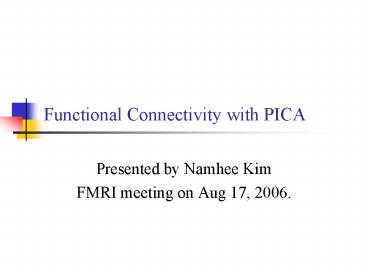Functional Connectivity with PICA - PowerPoint PPT Presentation
1 / 21
Title:
Functional Connectivity with PICA
Description:
Definition of functional connectivity (FC) ... Effective connectivity reflects the influence of neural system experts/ model based approach ... – PowerPoint PPT presentation
Number of Views:212
Avg rating:3.0/5.0
Title: Functional Connectivity with PICA
1
Functional Connectivity with PICA
- Presented by Namhee Kim
- FMRI meeting on Aug 17, 2006.
2
OUTLINE
- Definition of functional connectivity (FC)
- Probabilistic Independent Component Analysis
(PICA) in FSL - Revisit the study pharmacological fMRI study of
semantic and phonological processes - PICA Application
- Discussion
3
Definition of FC
- Functional connectivity is a way of summarizing
patterns of correlations among brain
systems/observational approach - Methods PCA, ICA, PICA, etc
- Effective connectivity reflects the influence of
neural system experts/ model based approach - Methods SEM, Dynamic Causal Modeling, etc
4
Overview of PCA, ICA PICA
- PCA is to find eigenimages via SVD
- Eigenimages are the patterns that account for the
most variance-covariance - ICA is dealing with non-Gaussian source
- Sufficient condition for unique source
- PICA is a further generalization of ICA
- Adding Noise and without assumption of full rank
(q lt p) in mixing matrix
5
Model Summary
6
Principle Component Directions
7
Decomposition method for PCA, ICA, and PICA
8
Revisit to the study pharmacological fMRI study
of semantic and phonological process
- Hypotheses
- FC would be greater with semantic tasks due to
deeper level of processing - L-Dopa would decrease FC due to restriction of
semantic network - L-Dopa is precursor for Dopamine and
administering to increase dopamine level in brain
9
Experimental design
- Design
- Drug effects
- L-Dopa and placebo
- Task effects
- semantic and phonological tasks
- 16 subjects (8 female)
- Right handed, native speaker, age range 2149
10
Experimental Design (Contd)
- Implementation
- 24 sec (task) and 30 sec (rest) for each run
- total 4 min 6 sec (4 runs)
- In each run, A cue word is presented for 3 sec
and followed by 15 words - Push button Yes or No
- if the words are related (for semantic) or rhymed
(phonological) with the cue word
11
Illustration of experiment design
12
Statistical Model and Results
- Model
- Results
- Difference in Mean RT between tasks (SegtPh)
- No drug effects and interaction effects
- Greater FC for phonological task
13
Results (Contd)
14
Results (Contd)
- Measure for functional connectivity
- Correlation of the time series between pairs of
region of interest (ROI) - Overall significance of the correlations
15
PAIR LIFG-LMTG
LIFG-LPAR
LMTG-LFUS
16
PICA application
- Activation map with threshold 0.5
- Threshold 0.5 means equal loss on both false
positive and false negative - Threshold 0.66 means loss of false positive is 2
times greater than that of false negative
17
Subj 11, phonological task with DA (1st
independent component)
18
Subj 11, phonological task with placebo (1st
independent component)
19
Subj 11, semantic task with DA (1st independent
component)
20
Subj 11, semantic task with placebo (1st
independent component)
21
Ordered eigen values































